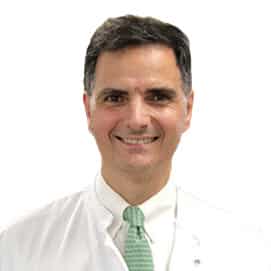Hodgkin's disease, also called Hodgkin's lymphoma or Hodgkin's lymphoma, is a malignant disease of the lymphatic system.
The number of new cases per year in Germany is estimated at 2-3 per 100,000. Men get sick more often than women, in a ratio of 3:2. The age at which the disease manifests itself has two frequency peaks in industrialized countries: the largest peak is between 20 and 30 years of age, and the second smaller peak is after 65 years of age. But, in principle, this disease can manifest itself at any age.
Since lymphoid tissue is found throughout the body, Hodgkin's disease can appear anywhere in the body. Hodgkin's lymphoma most commonly affects the lymph nodes, but the disease spreads to other organs such as the lungs, liver, bone marrow, and spleen, most often in the later stages of the disease. Without treatment, in almost all cases, the disease is fatal. But thanks to the methods of treatment available today, most patients can be cured.
Hodgkin's disease occurs when certain cells of the lymphatic system, in particular B-lymphocytes, degenerate due to changes in the genetic material ("Hodgkin cells"). With Hodgkin's lymphoma, the so-called Reed-Berezovsky-Sternberg cells are found under a microscope in the affected lymph nodes and organs, which are not formed in non-Hodgkin's lymphoma. These multinucleated cells arise from the fusion of several "Hodgkin cells".
Hodgkin's lymphomas are divided into four main types depending on how they appear under the microscope, which differ in frequency, course of the disease, and chances of recovery:
- Type with lymphocytic predominance (5-10 percent of cases)
- Nodular sclerosis type (50-60 percent)
- Mixed type (30 percent)
- Type with lymphocytic depletion (5-10 percent)
Symptoms
The first sign of Hodgkin's lymphoma in most cases is a dense (“rubber-like”) painless swelling of the lymph nodes. Most often, the lymph nodes of the neck swell first (about 70 percent), less often - the lymph nodes above the collarbone, in the armpits or groin.
In about a third of people with Hodgkin's lymphoma, the disease begins with swelling of the lymph nodes behind the breastbone (mediastinal lymph nodes), which can cause difficulty breathing, a feeling of tightness, and a persistent, irritating cough. If only a few lymph nodes are affected in the upper or lower abdomen, pain, tightness, and diarrhea of unknown origin may be symptomatic. After drinking alcohol, swollen lymph nodes can hurt (so-called "alcohol pain"), which is an extremely rare but relatively typical symptom of Hodgkin's lymphoma.
In about one-third of cases, non-specific general symptoms first appear, such as decreased performance, fatigue, feeling weak, and severe itching all over the body. When compiling a medical history, special attention should be paid to the presence or absence of the so-called “B-symptoms”, since it directly affects the staging and, therefore, the treatment of the disease.
"B-symptoms" include the following:
- Heavy sweating at night (after which you have to change clothes)
- Unwanted body weight loss of more than 10% in the past six months
- An increase in body temperature above 38 degrees Celsius with a variable course that cannot be explained by another cause.
Due to the multiplication of tumor cells in the lymph nodes, the immune system weakens, its balance is disturbed. Because of this, the patient is more likely to be at risk of bacterial, as well as viral and fungal infections. If the disease has spread beyond the lymph nodes to other organs, such as the bones or liver, symptoms may appear. So, when the bones are damaged, pain and bone fractures often occur. Bone marrow damage can lead to changes in the blood picture. If the liver is affected, due to its enlargement, there may be a feeling of tightness in the upper abdomen, and changes in liver function and biliary system parameters in the blood test may also appear.
Diagnostics
If cancer of the lymph nodes is suspected, various types of studies are carried out in order to clarify the type of cancer. Important steps in research to detect Hodgkin's lymphoma are:
- Physical examination (during the examination, the doctor pays special attention to the lymph nodes, lymphoid tissue in the nasopharynx, as well as the spleen and liver. With Hodgkin's lymphoma, these organs may be enlarged)
- Biopsy of lymph nodes. For this purpose, as a rule, the largest lymph node is removed from the most easily accessible group of lymph nodes, for example, in the neck, groin or armpits. Removal of lymph nodes occurs under local anesthesia. Obtaining a tissue sample is essential because a definitive diagnosis of Hodgkin's lymphoma requires the detection of the characteristic Hodgkin cells, Reed-Berezovsky-Sternberg cells.
- Lab tests
The decisive moment in confirming the diagnosis is the histological examination of the affected tissues. If the presence of Hodgkin's lymphoma is established, follow-up studies are carried out. They should show how much the disease has spread in the body.
Further diagnostic methods include:
- Bone marrow examination - especially in advanced stages of the disease
- Computed tomography (in patients with Hodgkin's lymphoma, computed tomography helps to visualize enlarged lymph nodes and more accurately determine their size. In addition, this is the only type of study that reliably indicates the presence or absence of lung damage in the initial diagnosis).
- Ultrasound examination of the abdominal organs, especially the spleen and liver (abdominal ultrasound)
- Magnetic resonance imaging (MRI) of the neck, abdominal organs and small pelvis
- If a bone lesion is suspected, bone scintigraphy
- Positron emission tomography (PET-CT meanwhile belongs to the standard methods for diagnosing Hodgkin's lymphoma and is recommended according to the guidelines of the working association of scientific medical societies (AWMF). In pediatric oncology, this method is also used to evaluate the effectiveness of treatment).
- Laboratory tests (blood tests explain the general condition of the patient, as well as give a picture of the functions of individual organs, such as the kidneys and liver. These tests include, among others, counting blood cells in a smear under a microscope (blood picture), determining the levels of proteins and immunoglobulins ( antibodies) in the blood, as well as measuring the erythrocyte sedimentation rate (ESR).In addition, a search is made for viral infections that also cause an increase in lymph nodes or may be involved in the occurrence of lymphoma.
Head of the Clinic of Oncology, Hematology and Palliative Medicine
Video
Request appointment
Useful links
Photo gallery








